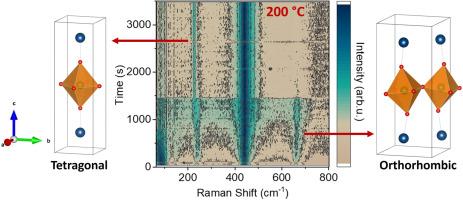用拉曼光谱原位观察La2NiO4+δ体和薄膜样品的相变
IF 9.3
1区 材料科学
Q1 MATERIALS SCIENCE, MULTIDISCIPLINARY
引用次数: 0
摘要
近年来,La2NiO4+δ由于其在中高温下的高电化学活性而成为固体氧化物燃料电池和电解槽中的氧电极,同时由于其可变氧化学计量而成为神经形态计算记忆器件的关键组成部分。将La2NiO4+δ集成到在不同温度和氧分压下工作的器件中需要了解高化学计量学(δ)对其晶体结构的影响。已知La2NiO4+δ在间隙位置容纳氧气,允许较大的δ值,高达0.16。此外,o掺杂温度相图是复杂的,随着δ的增加表现出多个相变。在此,我们使用拉曼光谱来监测o掺杂对相图及其包含的各种结构的影响。在整个工作中,我们研究了这种材料通常的陶瓷形式,以及薄膜形式。结果讨论了相变,化学膨胀,和一些可能的后果低平均晶粒尺寸固有的这种薄膜。本文章由计算机程序翻译,如有差异,请以英文原文为准。


In situ observation of phase transitions in La2NiO4+δ bulk and thin film samples via Raman spectroscopy
La2NiO4+δ has attracted increasing interest in recent years, both as oxygen electrode in solid oxide fuel cells and electrolysers due to its high electrochemical activity at intermediate-to-low temperatures, and as key component of memristive devices for neuromorphic computing, owing to its variable oxygen stoichiometry. The integration of La2NiO4+δ into devices operating at different temperatures and oxygen partial pressures requires knowledge of the effects of hyper-stoichiometry (δ) on its crystalline structure. La2NiO4+δ is known to accommodate oxygen at interstitial sites allowing for large δ values, up to ∼ 0.16. In addition, the O-doping - temperature phase diagram is known to be complex, exhibiting several phase transitions with increasing δ. Herein, we use Raman spectroscopy to monitor the effects of O-doping in the phase diagram and the various structures it contains. Throughout this work, we studied this material in its usual ceramic form, as well as in the form of thin films. Results are discussed in terms of phase transitions, chemical expansion, and some of the possible consequences of the low mean grain size inherent to such thin films.
求助全文
通过发布文献求助,成功后即可免费获取论文全文。
去求助
来源期刊

Acta Materialia
工程技术-材料科学:综合
CiteScore
16.10
自引率
8.50%
发文量
801
审稿时长
53 days
期刊介绍:
Acta Materialia serves as a platform for publishing full-length, original papers and commissioned overviews that contribute to a profound understanding of the correlation between the processing, structure, and properties of inorganic materials. The journal seeks papers with high impact potential or those that significantly propel the field forward. The scope includes the atomic and molecular arrangements, chemical and electronic structures, and microstructure of materials, focusing on their mechanical or functional behavior across all length scales, including nanostructures.
 求助内容:
求助内容: 应助结果提醒方式:
应助结果提醒方式:


